2018年最新初中英语教资考试教学设计题模板
- 格式:docx
- 大小:14.19 KB
- 文档页数:7
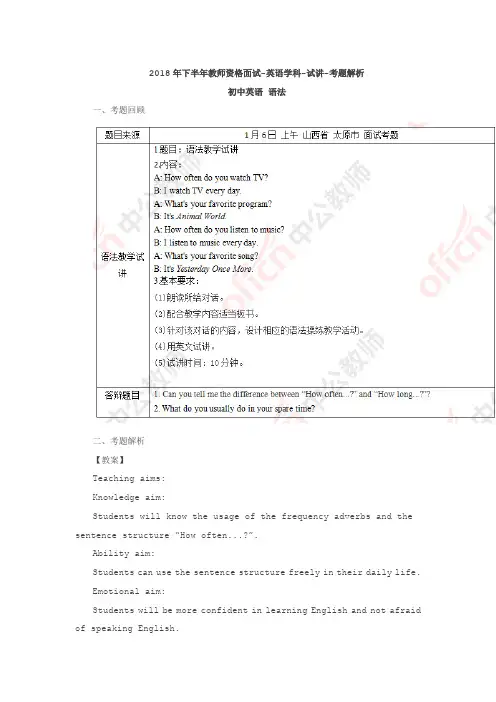
2018年下半年教师资格面试-英语学科-试讲-考题解析初中英语语法一、考题回顾二、考题解析【教案】Teaching aims:Knowledge aim:Students will know the usage of the frequency adverbs and the sentence structure “How often...?”.Ability aim:Students can use the sentence structure freely in their daily life.Emotional aim:Students will be more confident in learning English and not afraid of speaking English.Key and difficult point:Key Point: Students will know how to use the sentence structure in their daily life.Difficult Point: Students can cultivate their confidence in learning English.Teaching procedure:Step 1: Warming-up1. Greetings.2. Ask students what they usually do in their spare time and why, and ask some of them to share with the whole class.Step 2: Presentation1. Listen to the tape for the first time and find out what the speaker does every day, and then invite students share their answers.2. Ask students the following questions: how often does the speaker watch TV? How often does the speaker listen to music? And then write down the sentence on the blackboard.3. Explain the sentence structure to students: the sentence structure is used to ask questions about how many times something has been done or how many times a state exists in a given period of time.4. The teacher read the dialogue and ask students to read after it to get a deep understanding.Step 3: Practice1. Role-play. Ask students work in pairs and role play the dialogue. Then invite two groups to show in front of the class.2. Play a game: word cards. Invite two couples of students. Ask one student to choose the card in the box and then ask the other students the question “ how often do you...?” using the activities showed in the card, and then change their role.Step4: ProductionLet students work in groups of 4 and discuss on the topic: how often do you...? according to their own hobbies. After that invite two groups to present in the whole class.Step5: Summary and HomeworkSummary: ask a student to conclude the content of the lesson and summarize with the whole class.Homework: ask students to ask their friends “ how often do you...?” after class and write down on the exercise book.Blackboard design:【答辩题目解析】1. Can you tell me the difference between “How often...?” and “How long...?”?【参考答案】The first sentence structure is used to ask questions about how many times something has been done or how many times a state exists in a given period of time. The second sentence structure includes two different usage: one is used to ask how long does it take. It's mainly used to ask questions for a period of time; the other is used to ask for the length of something.2. What do you usually do in your spare time?【参考答案】I really have a great passion for sports, i like to do yoga, cycling and jogging. Take jogging for example. It stimulates me to learn more about body -building. Secondly, I am able to meet new friends throughmy hobby. Lastly, the hobby will teach me some self-discipline, because to do it regularly is so challenging.2018年下半年教师资格面试-英语学科-试讲-考题解析初中英语阅读一、考题回顾二、考题解析【教案】Teaching aims:Knowledge aim:Students will grasp and understand the main and detailed information of the passage.Ability aim:Students will improve their reading and speaking skills.Emotional aim:Students will foster the interest and desire of learning English and take part in speaking activities actively.Key and difficult point:Key Point: Students will totally understand the content of the passage.Difficult Point: Students will foster the interest of learning English, and take part in speaking activities.Teaching procedure:Step 1: Warming-up1. Greetings.2. Show students pictures about different types of transportation and naturally lead to today’s topic.Step 2: Pre-reading1. Ask students two questions and some volunteers will be invited to share their answers.Q1: How do you come to school?Q2: How do your parents go to work?2. Ask students to predict the main idea of the passage based on the above discussion and pictures on the screen.Step 3: While-reading1st reading: Ask students to read the passage for the first time and check their prediction. Besides, they need to find out which countries are mentioned in the passage and circle them.2nd reading: Ask students to read the passage for the second time and complete the following chart. Some students will be invited to finish it on the blackboard.Step4: Post-readingDiscussion: ask students to discuss the advantages and disadvantages of different modes of transportation. Four students ina group, after five minutes, some groups are supposed to show their results.Step5: Summary and HomeworkSummary: ask a student to conclude the content of the lesson and summarize with the whole class.Homework: ask students to investigate their friends’ way of going to school and find some interesting ways of transportation on the Internet.Blackboard design:【答辩题目解析】1. How to improve students’ reading and speaking ability in your class?【参考答案】It is very important to improve students’ reading and speaking abilities. In my class, I take three specific steps to improve their reading and speaking abilities. Firstly, before reading the article, I ask the students to guess the main idea of the article according to my questions and pictures on the screen. As you heard, this can not only exercise stude nts’ guessing ability, but also help them read the passage with questions. In the while-reading part, I set two times of reading, namely extensive reading and intensive reading. Obviously, students’ scanning ability and the ability to grasp detailed information can be improved. It also helps them form good reading habits. As for speaking ability, I organize a discussion activitywithout standard answers. Students can express their views freely in groups. In this way, their reading and speaking abilities can be improved a lot.2. How did you evaluate the performance of students in the class?【参考答案】Students are under a stage of growing and developing. They are eager to be evaluated and encouraged by their teachers. At the same time, students are different, and their acceptance and abilities of learning are different. Therefore, in my class, I have adopted a variety of different evaluations. For the students who answered correctly, I would praise them directly, such as “excellent”, “you can find the answer so f ast”. For those students who dare not answer questions or did not find out the answers, I just encouraged them and guided them to say the answers, and gave some encouraging comments, like “nice try!”, “you’ve made a great progress”. Also, some students mad e mistakes. In my class, instead of directly blaming the student for being wrong, I asked other students to help him/her and give them a proper evaluation.2018年下半年教师资格面试-英语学科-试讲-考题解析初中英语口语一、考题回顾二、考题解析【教案】Teaching aims:Knowledge aim:Students will know how to express their hobbies and interest.Ability aim:Students will improve their abilities of speaking and listening.Emotional aim:Students will be more confident in speaking English.Key and difficult point:Key Point: Students will know how to express their hobbies and interest in English.Difficult Point: Students will be more confident in speaking English and not be afraid of speaking English in public.Teaching procedure:Step 1: Warming-up1. Greetings.2.Sing a song of Mick Jackson to lead in the lesson.Step 2: Pre-speakingAsk students to look at the picture of Paul Jackson and Beijing Opera to predict what we will learn today.Step 3: While-speaking1st listening: Ask students to listen to the tape for the first time and check if their prediction is correct or not and get the main idea of the passage.2nd listening: Ask students to listen to the tape for the second time and tick and cross.Mike’s favorite actor is Paul Jackson. ( )Mike’s father often goes to see Beijing Opera on weekends.( ) Black September is a very successful thriller.( )3rd listening: Ask students to listen to the tape for the third time, read after the tape and invite several students to summarize how to express hobbies.Step4: Post-speakingAsk students to have a discussion about their hobbies, four students in a group and give them 5 minutes.Step5: Summary and HomeworkSummary: ask a student to conclude the content of the lesson and summarize with the whole class.Homework: ask students to introduce their favourite movies and share with their parents.Blackboard design:【答辩题目解析】1.How to improve students’ speaking ability?【参考答案】The topic should be interesting, which can arouse the interest of students In the class, teachers should give students’ subjectivity to the full play and give them more chance to communicate with each other. And organize various activities to encourage them to express themselves.2.Do you think blackboard design is important?【参考答案】There is no doubt that blackboard design plays a very important role in teaching process. First, it should has title. Secondly, The key and difficult points should be prominent, which enables students to master the knowledge. What’s more, the blackboard design should be logic and clear.。
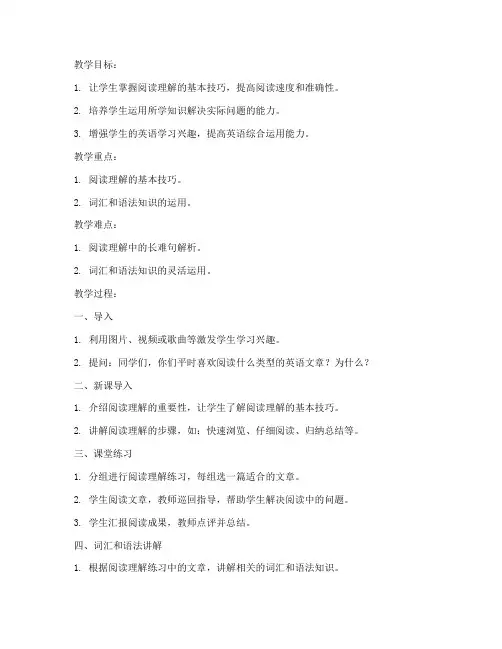
教学目标:1. 让学生掌握阅读理解的基本技巧,提高阅读速度和准确性。
2. 培养学生运用所学知识解决实际问题的能力。
3. 增强学生的英语学习兴趣,提高英语综合运用能力。
教学重点:1. 阅读理解的基本技巧。
2. 词汇和语法知识的运用。
教学难点:1. 阅读理解中的长难句解析。
2. 词汇和语法知识的灵活运用。
教学过程:一、导入1. 利用图片、视频或歌曲等激发学生学习兴趣。
2. 提问:同学们,你们平时喜欢阅读什么类型的英语文章?为什么?二、新课导入1. 介绍阅读理解的重要性,让学生了解阅读理解的基本技巧。
2. 讲解阅读理解的步骤,如:快速浏览、仔细阅读、归纳总结等。
三、课堂练习1. 分组进行阅读理解练习,每组选一篇适合的文章。
2. 学生阅读文章,教师巡回指导,帮助学生解决阅读中的问题。
3. 学生汇报阅读成果,教师点评并总结。
四、词汇和语法讲解1. 根据阅读理解练习中的文章,讲解相关的词汇和语法知识。
2. 通过例句和练习题,让学生掌握词汇和语法知识。
五、巩固练习1. 布置阅读理解作业,让学生课后练习。
2. 学生完成作业后,教师批改并讲解。
六、课堂小结1. 回顾本节课所学内容,强调阅读理解的基本技巧和词汇、语法知识。
2. 鼓励学生在日常生活中多阅读英语文章,提高英语水平。
教学反思:1. 本节课是否达到了预期的教学目标?2. 学生在阅读理解过程中是否掌握了基本技巧?3. 词汇和语法讲解是否清晰易懂?4. 如何改进教学方法,提高学生的学习兴趣和英语水平?教学评价:1. 学生在课堂练习和作业中的表现。
2. 学生对阅读理解技巧的掌握程度。
3. 学生在词汇和语法方面的进步。
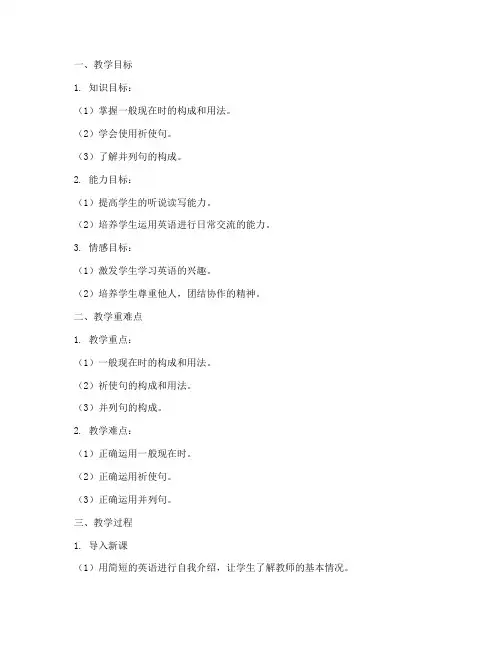
一、教学目标1. 知识目标:(1)掌握一般现在时的构成和用法。
(2)学会使用祈使句。
(3)了解并列句的构成。
2. 能力目标:(1)提高学生的听说读写能力。
(2)培养学生运用英语进行日常交流的能力。
3. 情感目标:(1)激发学生学习英语的兴趣。
(2)培养学生尊重他人,团结协作的精神。
二、教学重难点1. 教学重点:(1)一般现在时的构成和用法。
(2)祈使句的构成和用法。
(3)并列句的构成。
2. 教学难点:(1)正确运用一般现在时。
(2)正确运用祈使句。
(3)正确运用并列句。
三、教学过程1. 导入新课(1)用简短的英语进行自我介绍,让学生了解教师的基本情况。
(2)播放一段关于一般现在时的英语视频,激发学生的学习兴趣。
2. 新课讲解(1)讲解一般现在时的构成和用法,结合例句进行讲解。
(2)讲解祈使句的构成和用法,结合例句进行讲解。
(3)讲解并列句的构成和用法,结合例句进行讲解。
3. 练习巩固(1)进行听写练习,巩固学生对一般现在时的掌握。
(2)进行口语练习,让学生运用祈使句进行日常交流。
(3)进行阅读练习,让学生熟悉并列句的用法。
4. 小组合作(1)将学生分成若干小组,每组完成一份关于一般现在时、祈使句和并列句的练习。
(2)各小组互相批改练习,分享解题思路。
5. 总结回顾(1)教师对本次课程进行总结,强调重点和难点。
(2)布置课后作业,巩固所学知识。
四、教学评价1. 课堂表现:观察学生在课堂上的参与度、发言情况等。
2. 作业完成情况:检查学生的课后作业,了解学生对知识的掌握程度。
3. 期末考试:通过期末考试评估学生对本单元知识的掌握情况。
五、教学反思1. 教师应关注学生的个体差异,因材施教。
2. 教师应注重培养学生的英语实际应用能力。
3. 教师应激发学生的学习兴趣,提高学生的英语学习积极性。
备注:本教案设计模板仅供参考,具体教学过程可根据实际情况进行调整。
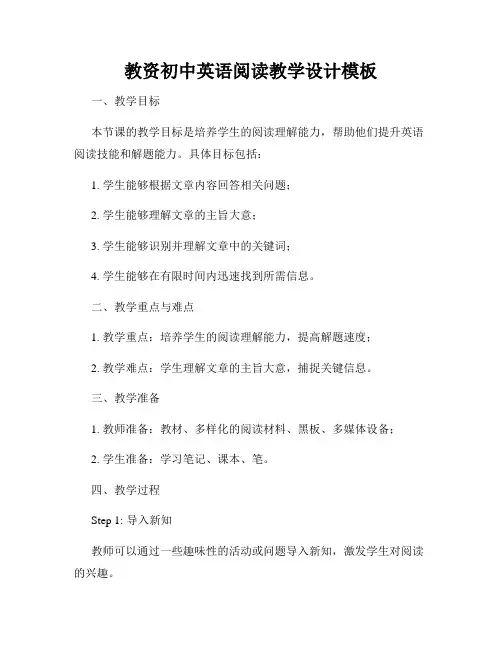
教资初中英语阅读教学设计模板一、教学目标本节课的教学目标是培养学生的阅读理解能力,帮助他们提升英语阅读技能和解题能力。
具体目标包括:1. 学生能够根据文章内容回答相关问题;2. 学生能够理解文章的主旨大意;3. 学生能够识别并理解文章中的关键词;4. 学生能够在有限时间内迅速找到所需信息。
二、教学重点与难点1. 教学重点:培养学生的阅读理解能力,提高解题速度;2. 教学难点:学生理解文章的主旨大意,捕捉关键信息。
三、教学准备1. 教师准备:教材、多样化的阅读材料、黑板、多媒体设备;2. 学生准备:学习笔记、课本、笔。
四、教学过程Step 1: 导入新知教师可以通过一些趣味性的活动或问题导入新知,激发学生对阅读的兴趣。
Step 2: 预测问题教师提供一段短文的标题或者一张图片,让学生根据标题或图片预测文章的内容。
Step 3: 快速阅读学生阅读整篇文章,不停顿,了解文章的大意。
可以要求学生标记关键词。
Step 4: 细读与分析学生再次读文章,这次注重细节和理解。
教师可以组织学生一起讨论文章中的关键信息,学生可以与同伴间互相讨论。
Step 5: 问题解答学生根据问题回答文章相关内容,可以小组合作,也可以个人完成。
教师批改并给予积极反馈。
Step 6: 拓展与延伸学生根据文章内容进行拓展学习,可以进行课堂小研究、小项目制作等形式。
五、教学评价教师可以通过以下方式对学生的学习情况进行评价:1. 课堂讨论中观察学生的表现及参与度;2. 学生的问题回答与解题情况;3. 学生的小组合作或个人表现;4. 学生的拓展学习成果。
六、课后作业布置相关的阅读练习或作业,要求学生在课后独立完成。
教师可以收集并及时批改,提供针对性的指导。
七、教学反思教师在实施教学过程中,要及时反思并总结教学效果,对不足之处进行改进,并在下次教学中加以改正。
注意:以上所述内容仅为设计模板示例,实际教学中还需根据具体教学内容进行调整与完善。
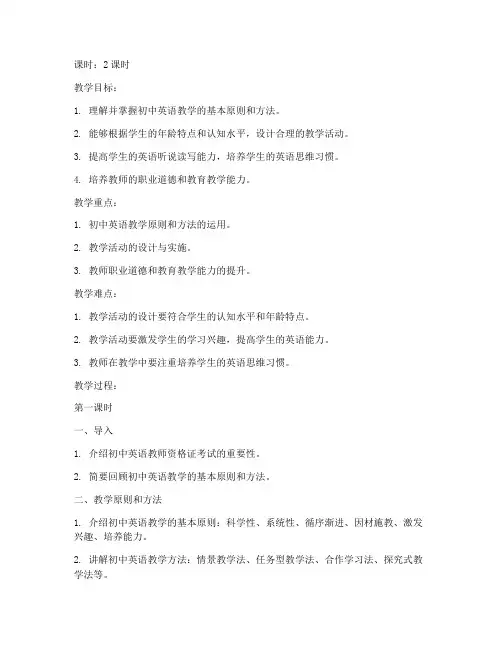
课时:2课时教学目标:1. 理解并掌握初中英语教学的基本原则和方法。
2. 能够根据学生的年龄特点和认知水平,设计合理的教学活动。
3. 提高学生的英语听说读写能力,培养学生的英语思维习惯。
4. 培养教师的职业道德和教育教学能力。
教学重点:1. 初中英语教学原则和方法的运用。
2. 教学活动的设计与实施。
3. 教师职业道德和教育教学能力的提升。
教学难点:1. 教学活动的设计要符合学生的认知水平和年龄特点。
2. 教学活动要激发学生的学习兴趣,提高学生的英语能力。
3. 教师在教学中要注重培养学生的英语思维习惯。
教学过程:第一课时一、导入1. 介绍初中英语教师资格证考试的重要性。
2. 简要回顾初中英语教学的基本原则和方法。
二、教学原则和方法1. 介绍初中英语教学的基本原则:科学性、系统性、循序渐进、因材施教、激发兴趣、培养能力。
2. 讲解初中英语教学方法:情景教学法、任务型教学法、合作学习法、探究式教学法等。
三、教学活动设计1. 分析学生的年龄特点和认知水平。
2. 设计符合学生特点的教学活动,如:角色扮演、小组讨论、游戏、竞赛等。
四、教学实践1. 教师进行教学活动示范。
2. 学生分组进行教学活动实践。
五、总结1. 总结本节课的教学内容。
2. 强调教学活动设计的重要性。
第二课时一、复习导入1. 回顾上一节课的教学内容。
2. 提出本节课的学习目标。
二、教学活动设计与实施1. 学生分组,每组设计一个教学活动。
2. 各组进行教学活动展示,其他组进行评价。
三、教师职业道德与教育教学能力提升1. 讲解教师职业道德规范。
2. 分析教育教学能力的重要性。
3. 提出提升教育教学能力的途径。
四、案例分析1. 分析典型案例,探讨初中英语教学中的问题。
2. 学生分组讨论,提出解决对策。
五、总结1. 总结本节课的教学内容。
2. 强调教师职业道德和教育教学能力的重要性。
教学评价:1. 学生对教学原则和方法的理解程度。
2. 学生参与教学活动的积极性。
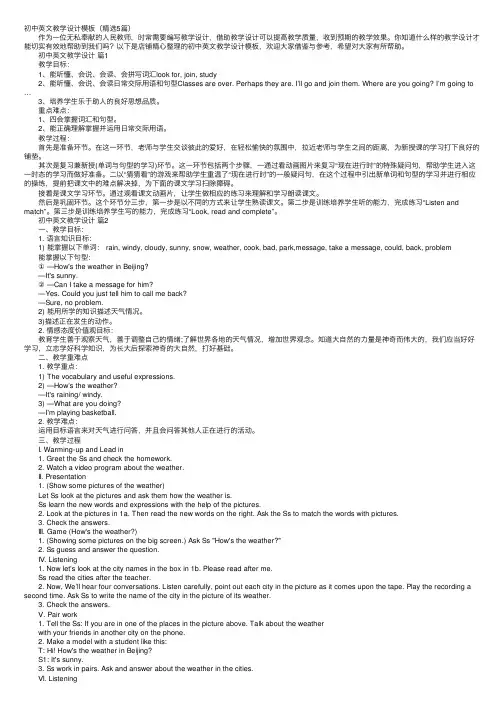
初中英⽂教学设计模板(精选5篇) 作为⼀位⽆私奉献的⼈民教师,时常需要编写教学设计,借助教学设计可以提⾼教学质量,收到预期的教学效果。
你知道什么样的教学设计才能切实有效地帮助到我们吗?以下是店铺精⼼整理的初中英⽂教学设计模板,欢迎⼤家借鉴与参考,希望对⼤家有所帮助。
初中英⽂教学设计篇1 教学⽬标: 1、能听懂、会说、会读、会拼写词汇look for, join, study 2、能听懂、会说、会读⽇常交际⽤语和句型Classes are over. Perhaps they are. I’ll go and join them. Where are you going? I’m going to … 3、培养学⽣乐于助⼈的良好思想品质。
重点难点: 1、四会掌握词汇和句型。
2、能正确理解掌握并运⽤⽇常交际⽤语。
教学过程: ⾸先是准备环节。
在这⼀环节,⽼师与学⽣交谈彼此的爱好,在轻松愉快的氛围中,拉近⽼师与学⽣之间的距离,为新授课的学习打下良好的铺垫。
其次是复习兼新授(单词与句型的学习)环节。
这⼀环节包括两个步骤,⼀通过看动画图⽚来复习“现在进⾏时”的特殊疑问句,帮助学⽣进⼊这⼀时态的学习⽽做好准备。
⼆以“猜猜看”的游戏来帮助学⽣重温了“现在进⾏时”的⼀般疑问句,在这个过程中引出新单词和句型的学习并进⾏相应的操练,提前把课⽂中的难点解决掉,为下⾯的课⽂学习扫除障碍。
接着是课⽂学习环节。
通过观看课⽂动画⽚,让学⽣做相应的练习来理解和学习朗读课⽂。
然后是巩固环节。
这个环节分三步,第⼀步是以不同的⽅式来让学⽣熟读课⽂。
第⼆步是训练培养学⽣听的能⼒,完成练习“Listen and match”。
第三步是训练培养学⽣写的能⼒,完成练习“Look, read and complete”。
初中英⽂教学设计篇2 ⼀、教学⽬标: 1. 语⾔知识⽬标: 1) 能掌握以下单词: rain, windy, cloudy, sunny, snow, weather, cook, bad, park,message, take a message, could, back, problem 能掌握以下句型: ① —How's the weather in Beijing? —It's sunny. ② —Can I take a message for him? —Yes. Could you just tell him to call me back? —Sure, no problem. 2) 能⽤所学的知识描述天⽓情况。
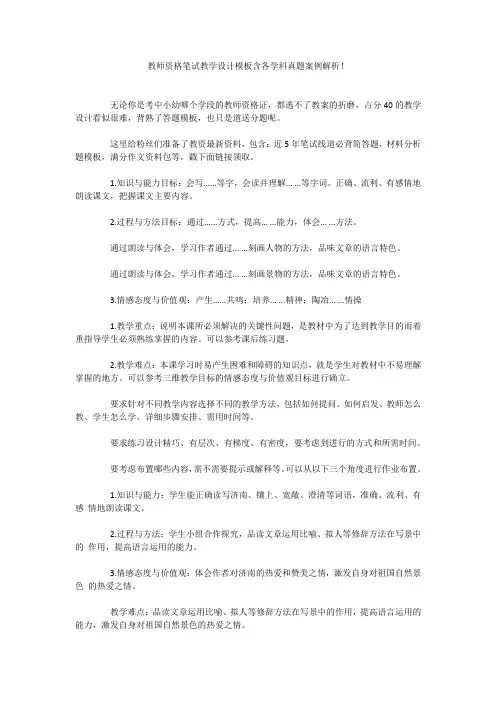
教师资格笔试教学设计模板含各学科真题案例解析!无论你是考中小幼哪个学段的教师资格证,都逃不了教案的折磨,占分40的教学设计看似很难,背熟了答题模板,也只是道送分题呢。
这里给粉丝们准备了教资最新资料,包含:近5年笔试线道必背简答题,材料分析题模板,满分作文资料包等,戳下面链接领取。
1.知识与能力目标:会写......等字,会读并理解... ...等字词。
正确、流利、有感情地朗读课文,把握课文主要内容。
2.过程与方法目标:通过......方式,提高... ...能力,体会... ...方法。
通过朗读与体会,学习作者通过... ...刻画人物的方法,品味文章的语言特色。
通过朗读与体会,学习作者通过... ...刻画景物的方法,品味文章的语言特色。
3.情感态度与价值观:产生......共鸣;培养... ...精神;陶冶... ...情操1.教学重点:说明本课所必须解决的关键性问题,是教材中为了达到教学目的而着重指导学生必须熟练掌握的内容。
可以参考课后练习题。
2.教学难点:本课学习时易产生困难和障碍的知识点,就是学生对教材中不易理解掌握的地方。
可以参考三维教学目标的情感态度与价值观目标进行确立。
要求针对不同教学内容选择不同的教学方法,包括如何提问、如何启发、教师怎么教、学生怎么学、详细步骤安排、需用时间等。
要求练习设计精巧、有层次、有梯度、有密度,要考虑到进行的方式和所需时间。
要考虑布置哪些内容,需不需要提示或解释等。
可以从以下三个角度进行作业布置。
1.知识与能力:学生能正确读写济南、镶上、宽敞、澄清等词语,准确、流利、有感情地朗读课文。
2.过程与方法:学生小组合作探究,品读文章运用比喻、拟人等修辞方法在写景中的作用,提高语言运用的能力。
3.情感态度与价值观:体会作者对济南的热爱和赞美之情,激发自身对祖国自然景色的热爱之情。
教学难点:品读文章运用比喻、拟人等修辞方法在写景中的作用,提高语言运用的能力,激发自身对祖国自然景色的热爱之情。
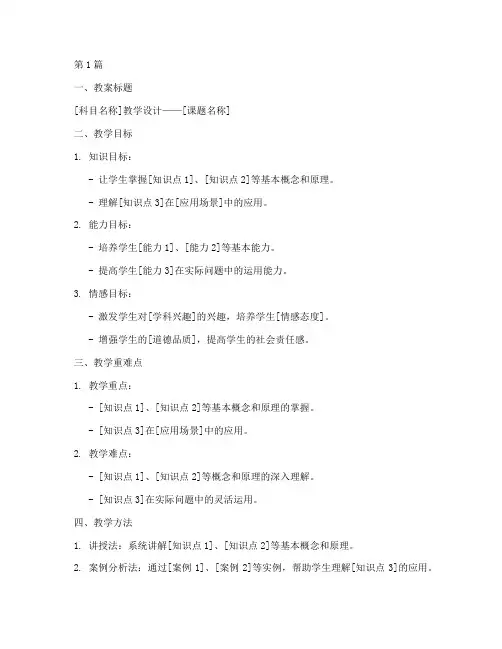
第1篇一、教案标题[科目名称]教学设计——[课题名称]二、教学目标1. 知识目标:- 让学生掌握[知识点1]、[知识点2]等基本概念和原理。
- 理解[知识点3]在[应用场景]中的应用。
2. 能力目标:- 培养学生[能力1]、[能力2]等基本能力。
- 提高学生[能力3]在实际问题中的运用能力。
3. 情感目标:- 激发学生对[学科兴趣]的兴趣,培养学生[情感态度]。
- 增强学生的[道德品质],提高学生的社会责任感。
三、教学重难点1. 教学重点:- [知识点1]、[知识点2]等基本概念和原理的掌握。
- [知识点3]在[应用场景]中的应用。
2. 教学难点:- [知识点1]、[知识点2]等概念和原理的深入理解。
- [知识点3]在实际问题中的灵活运用。
四、教学方法1. 讲授法:系统讲解[知识点1]、[知识点2]等基本概念和原理。
2. 案例分析法:通过[案例1]、[案例2]等实例,帮助学生理解[知识点3]的应用。
3. 讨论法:引导学生就[知识点1]、[知识点2]等概念和原理进行讨论,加深理解。
4. 实践操作法:让学生通过[实验1]、[实验2]等实践操作,巩固所学知识。
五、教学过程1. 导入环节:- 通过[导入话题]引起学生兴趣,引入新课。
- 播放[导入视频]或展示[导入图片],激发学生思考。
2. 知识讲解环节:- 讲解[知识点1]、[知识点2]等基本概念和原理。
- 结合[案例1]、[案例2]等实例,帮助学生理解[知识点3]的应用。
3. 案例分析环节:- 引导学生就[案例1]、[案例2]等实例进行讨论,分析问题。
- 总结案例中的关键点,帮助学生掌握[知识点1]、[知识点2]等。
4. 实践操作环节:- 学生进行[实验1]、[实验2]等实践操作,巩固所学知识。
- 教师巡回指导,解答学生疑问。
5. 总结与反思环节:- 对本节课所学内容进行总结,强调重点和难点。
- 引导学生反思自己的学习过程,提出改进意见。
六、教学评价1. 课堂表现评价:- 观察学生在课堂上的参与度、互动情况等。
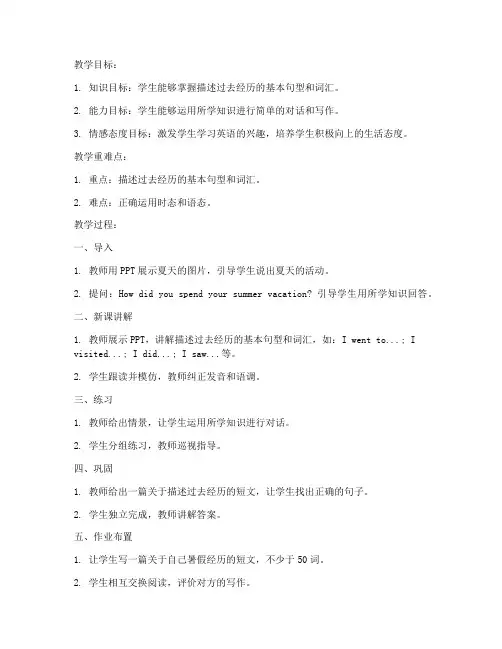
1. 知识目标:学生能够掌握描述过去经历的基本句型和词汇。
2. 能力目标:学生能够运用所学知识进行简单的对话和写作。
3. 情感态度目标:激发学生学习英语的兴趣,培养学生积极向上的生活态度。
教学重难点:1. 重点:描述过去经历的基本句型和词汇。
2. 难点:正确运用时态和语态。
教学过程:一、导入1. 教师用PPT展示夏天的图片,引导学生说出夏天的活动。
2. 提问:How did you spend your summer vacation? 引导学生用所学知识回答。
二、新课讲解1. 教师展示PPT,讲解描述过去经历的基本句型和词汇,如:I went to...; I visited...; I did...; I saw...等。
2. 学生跟读并模仿,教师纠正发音和语调。
三、练习1. 教师给出情景,让学生运用所学知识进行对话。
2. 学生分组练习,教师巡视指导。
四、巩固1. 教师给出一篇关于描述过去经历的短文,让学生找出正确的句子。
2. 学生独立完成,教师讲解答案。
五、作业布置1. 让学生写一篇关于自己暑假经历的短文,不少于50词。
2. 学生相互交换阅读,评价对方的写作。
本节课通过图片、情景对话等形式,让学生在轻松愉快的氛围中学习描述过去经历的基本句型和词汇。
在教学过程中,教师注重培养学生的实际运用能力,通过小组练习、巩固环节,让学生在互动中提高英语水平。
在作业布置环节,教师鼓励学生运用所学知识进行写作,提高学生的综合运用能力。
在教学过程中,教师应关注学生的学习需求,及时调整教学策略,以提高教学效果。

Teaching Contents:The passage is about ……. It points out……Teaching Objectives:(1)Knowledge aims*Students can know/learn ……*Students can master the main idea of this passage.*Students can read the new words “……单词” and understand the meaning of the sentence patterns “……句型“ correctly(听力).*Students will be able to get the meaning of the new words and write them down .*Students can learn the pronunciation of ….*Students will understand the general idea pf the passage (高年级).*Students will get the principle of V-ing(高年级).(2)Ability aims*Students can improve their reading ability to catch the key and detailed information .*Students will improve their reading skills by skimming and scanning the passage(高年级).*Students can improve their speaking/listening ability for……*Students can use the new words to make sentences .*Students can communicate with others in given situation .*Students will be able to talk about ……(by using the sentence pattern ).(3)Emotional aims*Students will be interested in learning English(万能语句,想不到其他的就写这个)*Students can improve their confidence in learning English, and aren’t afraid of speaking English in class*After learning the …… , students will feel……Teaching Key and Difficult Points*How to improve students’ reading abilities and help them to have a better understanding of …… (阅读)*How to make students improve their listening and speaking abilities and make them learn to describe ……correctly(听说)*How to help students to understand and use the sentence patterns to talk with others.(口语)Major Steps阅读课Step 1:Pre-reading (…minutes)【引起学生注意、激发兴趣和学习动机,导入要有针对性,可以采取图片、歌曲、视频等方法。
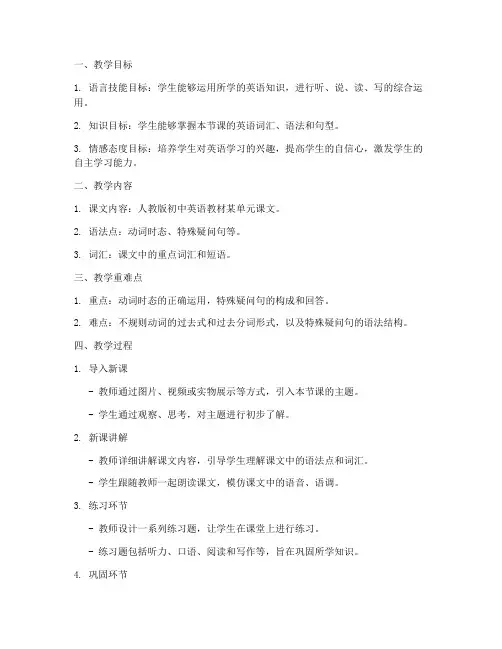
一、教学目标1. 语言技能目标:学生能够运用所学的英语知识,进行听、说、读、写的综合运用。
2. 知识目标:学生能够掌握本节课的英语词汇、语法和句型。
3. 情感态度目标:培养学生对英语学习的兴趣,提高学生的自信心,激发学生的自主学习能力。
二、教学内容1. 课文内容:人教版初中英语教材某单元课文。
2. 语法点:动词时态、特殊疑问句等。
3. 词汇:课文中的重点词汇和短语。
三、教学重难点1. 重点:动词时态的正确运用,特殊疑问句的构成和回答。
2. 难点:不规则动词的过去式和过去分词形式,以及特殊疑问句的语法结构。
四、教学过程1. 导入新课- 教师通过图片、视频或实物展示等方式,引入本节课的主题。
- 学生通过观察、思考,对主题进行初步了解。
2. 新课讲解- 教师详细讲解课文内容,引导学生理解课文中的语法点和词汇。
- 学生跟随教师一起朗读课文,模仿课文中的语音、语调。
3. 练习环节- 教师设计一系列练习题,让学生在课堂上进行练习。
- 练习题包括听力、口语、阅读和写作等,旨在巩固所学知识。
4. 巩固环节- 教师组织学生进行小组讨论,让学生运用所学知识,讨论课文中的问题。
- 学生在讨论过程中,互相帮助,共同提高。
5. 作业布置- 教师布置课后作业,包括课文背诵、单词默写、语法练习等。
- 作业要求学生独立完成,培养学生的自主学习能力。
五、教学评价1. 课堂表现:观察学生在课堂上的参与度、回答问题的准确性等。
2. 作业完成情况:检查学生的课后作业,了解学生对所学知识的掌握程度。
3. 期末考试:通过期末考试,全面评估学生对本节课内容的掌握情况。
六、教学反思1. 教师在课后对教学过程进行反思,总结教学经验,提高教学水平。
2. 教师关注学生的学习需求,及时调整教学策略,确保教学效果。
3. 教师鼓励学生积极参与课堂活动,激发学生的学习兴趣,提高学习效果。
注:以上教案模板仅供参考,具体教学过程可根据实际情况进行调整。
教资笔试英语教案模板教资面试初中英语教案【篇1:2021教师资格面试指导初中英语听说课】教师资格面试指导——初中英语听说课随着教师资格证考试的全国统考化,考试难度也随之增加,尤其是教师资格证考试中的面试环节(以下简称教资面试)。
这无形中也给考生带来了诸多压力,想要考取初中英语教师资格证,就必须要过试讲这一关。
在教资面试的初中英语试讲中,考生可能会抽到多种类型的试讲题目。
如果考生抽到的题目中有以下类似要求,则可以将其设计为一堂听说课:1.重点练习学生听说的能力;2.要求学生展示对话;3.设计听后的口语活动。
今天我们先来谈一谈如何设计初中英语的听说课。
听说是学习英语所需要培养的技能,因此在技能教学中,我们最常用的方式就是pwp模式(pre-listening,while-listening,post-listening)。
那么在这个pwp模式的每个环节中,我们具体要根据什么来设计课堂环节呢?根据义务教育阶段的英语课程标准,我们总结出,在听前阶段我们主要是以熟悉相关词语和句型、提出需要解决的问题为目的、和明确具体任务为目的来设计教学活动;在听中阶段,则以听信息,排顺序、列项目、补全文字等完成各种任务为目的;在听后阶段,也就是练习说的环节,设计的教学活动应以口头回答问题、模拟或表演情景对话、小组讨论等形式来展开。
因此考生在设计课堂活动时,要紧紧围绕以上的关键信息设计听说课。
可以将听说课的流程设计为以下几步:导入,听前,听中,听后,小结作业。
首先我们从课堂导入开始说起。
初中英语教学最常用的导入方式有两种,一个是温故知新导入法(以复习、提问、表演上节课学过的对话等开始,向学生提供新、旧知识联系的要点),一个是设置情景导入法(指综合利用图片、音乐、视频等设备,结合教师语言、学生活动等因素,制造出一种符合教学需要的情景的导入方法)。
一般来讲,在面试中为了吸引考官的眼球,建议考生采用设置情景导入方式。
设置情景导入方式又可以分为以下几种:实物导入法、游戏导入法、创疑导入法、音视频导入法、生活实例导入法、人物故事导入法、名言名句、活动表演导入法等。
1 / 7 Teaching Objectives: ? (1) Knowledge objectives
① (all)Stude nts master the key words/ phrases: ... ② (all)Stude nts lear n the target Ian guages: ... ③ (阅读 /听力) Students read/ listen the passage carefully and get specific information. ④ (写作) Ss can choose the right structure and right tense to write a compositi on. ( 2) Ability objectives ① Through doing tasks, students practice and consolidate 巩固 target Ianguages. ② Students improve their listening/speaking/reading/writing abilities and communicative competence. ③ (阅读) Stude nts read the passage and know clear about ... ④ (阅读) Stude nts discuss in pairs or in groups and do exercises to un dersta nd the text. ( 3) Emotional objectives ① Stude nts improve liste ning and speak ing skills by joining in the tasks. ② Stude nts can express( what ... are )accurately. ③ Stude nts love to share ... with others and build a deeper relati on ship with ... ④ Stude nts cultivate the habit of (joining a En glish group ) to improve their Ian guage skills.
Teaching Contents: (对话) The dialogue talks about ... (阅读) The class is to read.../ It is a passage about ... (听说 /听力) It is a listening and speaking lesson talking about... (口语) This is a speaking lesson whose topic is about “how to... ” (语法) This is a grammar lesson about tag questions. (读写) This lesson is about reading and writing ... (写作) It is a guided writing lesson. The topic is ...
Teaching Key points: (all)Students master the key words and target languages, and can use then correctly. (阅读) Students read the passage and get specific information from the passage. (听力) Ss listen to the tape and do exercise 2b and 2c. (听说) Communicate with others on the topic.
Teaching difficult points: (all)Students freely talk about ... in real communication. ( logically/ smoothly/ correctly ) (读写 /写作) Ss master the skills of writing a proper passage about ...in right way. Teaching Procedures: Step 1 Lead-in ( 5 minutes) Activity 1: Review T: What ... do you learn in school? Can you say it in English? 2 / 7
(Justification: Reviewing what ss have learned can help ss get ready for the new lesson. ) Activity 2: Sing a song/ Play a short film The teacher guides ss to sing a song .../ plays a short film (Justification: Sing a song/ play a film clip that is closely related to the topic of the lesson can arouse ss'learning interest.) Activity 3: Free talk (Justification: Through free talk, ss get prepared to listening tasks. / help ss know what they will learn in class. )
听力课 Step 1 Pre-listening ( 5 minutes ) Activity : Free talk T: Good morning! Look at ... So tell me ... (Justification: Free talk will attract ss 'interest and teaching content would be naturally led in.) Step 2 While-listening ( 25 minutes) Activity 1: Listen to the tape and finish exercise 2b./ summarize the main idea of the conversation. Activity 2:Listen again. Make up a dialogue according the content of tape. ( T: Talk about ... ) (Teacher show the tapescript on the PPT. Ss read the conversation and circle the key words and sentences in the conversation. The teacher write these on the blackboard such as “...”) Activity 3: Give a report. ( T: Several groups come to the front to act out your dialogue, and others give some evaluation. ) (Justification: Through listening and speaking activities, ss master the language knowledge and improve language skills.) Step 3 Post-listening ( 10 minutes) Activity 1: Discussion. (T: Talk about ...) (Justification: Ss use the language knowledge in real communication, which can associate the knowledge with real life. 联系 ) Activity 2: Make a dialogue. Ss work in groups of four to make up a new dialogue by imitating the conversation, especially by using the key words and sentences in the conversation. Activity 3: Role play. Ss act out their dialogue group by group. When one group is acting, the teacher and other ss act as judges. After the performance, the teacher corrects the common language mistakes. At the end, the whole class select one group who performs the best. (Justification: Ss develop their speaking skills and also apply the key knowledge into practice. ) 口语课
Step 1 Pre-task ( 3 minutes) Activity 1: Brainstorm